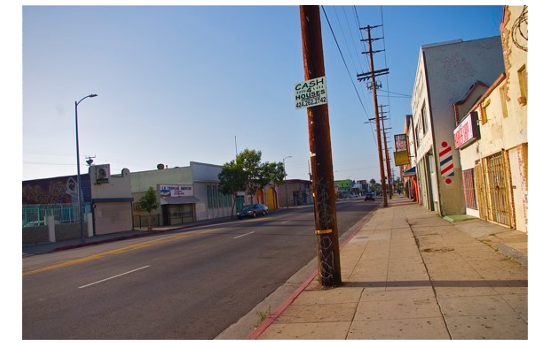CommentsPLANNING WATCH--Even though Los Angeles has a nearly perfect climate, fall is best time to plant new trees and save LA’s existing trees.
Trees, after all, are nature’s way to combat the climate crisis by cooling heat islands and sequestering rapidly rising atmospheric carbon. In addition, trees enhance rainwater absorption, provide shade, generate oxygen, buffer glare and noise, host urban wildlife, and are beautiful in their own right. (Photo above: Canopy of blooming Jacarandas in Los Angeles
Historically, only five species of trees are native to Los Angeles, but due to LA’s semi-tropical climate, over 1000 tree species now grow here, and the City permits 150 tree species on its parkways (the city-owned planting strip between the sidewalk and the street).
In surrounding cities, the urban forest is a basic municipal responsibility, and each city’s urban forestry office does an admirable job, such as Burbank, Beverly Hills, Culver City, and Santa Monica. But if you live, work, or visit Los Angeles, there are few people at City Hall whose job includes the preparation, implementation, and monitoring of an urban forest master plan.
What may be obvious to you – the vital importance of urban trees -- is not obvious to LA’s elected officials, who routinely allocate over half of the City’s budget to policing, despite expensive lawsuits and widescale protests. As a result, the LAPD’s budget is over 2000 times larger than LA’s Urban Forest Division.
This is why so many Los Angeles streets remain poorly planted or completely treeless.

The bad: Typical treeless street in Los Angeles. Note the overhead wires.
Here are a few commonsense rules to preserve LA’s existing trees and select the right species for fall planting:
- Stick with the planting theme that already exists on your block, unless it is a poor choice, such as Ficus or Carob, both notorious sidewalk lifters.
- Large streets deserve large trees, while narrow streets should have smaller trees, especially when battling overhead wires.
- Trees should be planted with a root barrier to protect sidewalks and water mains.
- Irrigation should be slow, deep, and occasional. Most trees will establish themselves within five years, but they will still need watering during heat waves and droughts.
When planting trees, you should carefully take stock of seven barriers to a proper urban forest in Los Angeles.
- It takes a long time for a small tree to become a mature tree, so anything you can do to preserve existing trees is welcome. This means occasional deep watering in dry months and careful pruning, avoiding destructive buzz cuts.
- If trees become diseased, you should contact Urban Forestry (800.996.2489) or hire a certified arborist to determine if they can be saved.
- When selecting a tree, remember that LA’s climate is becoming hotter and drier. UC Davis has issued this guide for trees that can best withstand climate change in California. In addition, Los Angeles Country has issued a Handbook for Drought Tolerant Gardens, including recommended trees.
- Los Angeles is losing its existing tree cover through real estate development, especially the replacement of smaller homes with larger, more expensive McMansions. USC professor Travis Longcore has carefully documented this loss of tree cover in LA neighborhoods subject to real estate speculation.
- Unlike other large cities, which dedicate 1 percent of their budgets to their urban forest, Los Angeles only allocates .25 percent of its budget to Urban Forestry.
- Responsibility for LA’s urban forest is poorly coordinated among the Bureau of Street Services Urban Forestry Division, City Plants (a non-profit), a City Forest Officer at the Board of Public Works, Water and Power, which has its own tree trimming contracts, and Recreation and Parks.
- State law and the LA City Charter require a comprehensive General Plan, and LA’s Plan only devotes a half page to the urban forest, even though many cities have prepared an entire Urban Forest General Plan element. In fact, Jill Stewart and Ileana Wachtel published a detailed inventory of the urban forest plans of other major cities and contrasted them to LA’s meager effort.
Three things you can do right now:
Plant appropriate trees over the next several months that can withstand a hotter, drier Los Angeles, and that match existing trees.
Water trees on your own property and/or the parkway near your residence if the current drought continues.
Support local advocacy groups, such as Angelenos For Trees, that are devoted to the preservation and expansion of LA’s urban forest, including an urban forest master plan.
(Dick Plakin is a former Los Angeles city planner who reports on local planning issues for CityWatchLA. He serves on the board of United Neighborhoods for Los Angeles (UN4LA) and co-chair of the new Greater Fairfax Residents Association. Previous columns are available at the CityWatchLA archives and https://plan-itlosangeles.blogspot.com/ . Please send corrections to [email protected])
-cw














